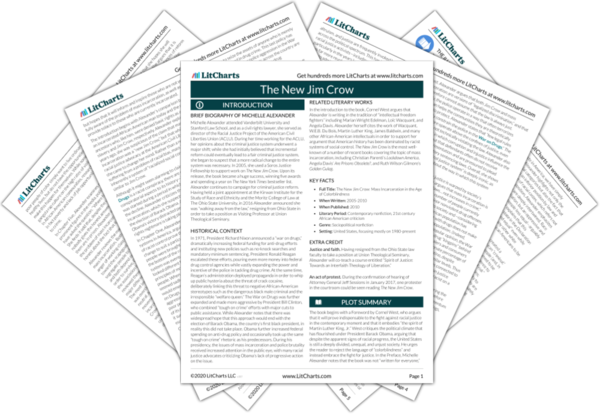In addition to having symbolic meaning, the War on Drugs is simply the central topic of the book. The first time the phrase was used in a political context was in 1971, by President Richard Nixon. Although there has been a long history of federal anti-drug legislation in the United States—including under Nixon’s administration—the phrase War on Drugs is most closely associated with the anti-drug efforts of President Ronald Reagan. Reagan oversaw the militarization of the police, the institution of mandatory minimum sentences, and massive increases in federal funding to combat drug crime. The Reagan administration is also now known to have deliberately produced propaganda in order to promote racist stereotypes such as the “crack baby” and “welfare queen.” However, the War on Drugs did not subside after Reagan left office. In Alexander’s words, President Bill Clinton “escalated the drug war beyond what conservatives had imagined possible,” and funding for anti-drug policing increased further under President Obama. Although the Obama administration rejected the use of the phrase “War on Drugs,” its policies did not reflect this shift away from war rhetoric.
As well as being an actual set of policies, the War on Drugs is also a metaphor that brings together many of the most charged racial, economic, and political issues of our era. Many people consider the idea of conducting a “war” on drug abuse to be common sense, part of a “tough on crime” approach that will ultimately make society healthier and safer. However, Alexander digs deeper into what has motivated the government’s single-minded attack on drug abuse, suggesting that it may be guided less by social welfare than a desire to police, control, and suppress poor people of color. Indeed, the word “drugs” as it is used in “War of Drugs” is something of a misnomer. Alcohol, cigarettes, caffeine, LSD, and powder cocaine are all examples of drugs that have not been targeted with nearly the same level of aggression as drugs associated with African Americans—particularly crack cocaine. The overall impression provided by the book is that the War on Drugs more closely resembles an assault on the freedom and liberty of poor black and Latino Americans than a productive program for social wellbeing.
The War on Drugs Quotes in The New Jim Crow
In some states, black men have been admitted to prison on drug charges at rates twenty to fifty times greater than those of white men. And in major cities wracked by the drug war, as many as 80 percent of young African American men now have criminal records and are thus subject to legalized discrimination for the rest of their lives. These young men are part of a growing undercaste, permanently locked up and locked out of mainstream society.
Few legal rules meaningfully constrain the police in the War on Drugs. This may sound like an overstatement, but upon examination it proves accurate. The absence of significant constraints on the exercise of police discretion is a key feature of the drug war's design. It has made the roundup of millions of Americans for nonviolent drug offenses relatively easy.












